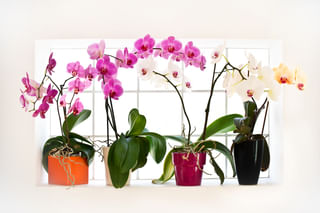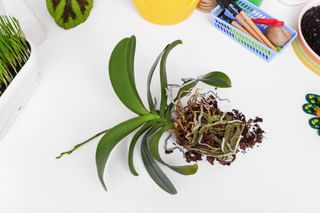How to take care of Orchids
Orchids are very popular houseplants/flowers around the world. They come in all kinds of shapes and sizes and are generally low-maintenance and easy to take care of. In this plant care guide, we're going to look at how you can take care of an Orchid.
Orchids are very popular houseplants/flowers around the world. They come in all kinds of shapes and sizes and are generally low-maintenance and easy to take care of. In this plant care guide, we're going to look at how you can take care of an Orchid. This plant care guide will explain the happy medium for Orchid plant care, because there are hundreds of different types of Orchids. Each of these types has slightly different plant care needs, so it's very difficult to explain how each individual type likes to be cared for.
This plant care guide will explain what every Orchid out there has in common and this will help you to take care of your Orchid and help it thrive. These are the topics we're going to look at in this plant care guide:
- The perfect soil for your Orchid
- Growing your Orchid in Leca
- Watering your Orchid
- Humidity for your Orchid
- Sunlight requirements for your Orchid
- Fertilizing your Orchid
- Toxicity for your pets
Let's get started and learn to take care of your Orchid to keep it happy and healthy for years to come!
The perfect soil for your Orchid
In all other plant care guides, I start by explaining how you should water your plants. But this is a little different when it comes to Orchids. Orchids, unlike almost all other plants, don't grow in soil. Orchids, in their natural habitat, grow on the bark of trees, rather than in soil. You can see this when you look at their "roots". These roots look a lot like air roots, like you would see on a Philodendron or Monstera. They're thick hooks that the Orchid uses to hold onto the tree.
Now that we know that the Orchid grows on tree trunks and bark in their natural habitat, we also have a good idea about what's the best type of soil for an Orchid. The best type of soil for an Orchid is no soil at all, but rather wood chips or Leca. These woods chips or Leca hold onto very little moisture and let excess water drain to the bottom of the pot. This amount of moisture is too little for most other houseplants, but is perfect for your Orchid. It absorbs the moisture from these wood chips or Leca, rather than getting it from water at the bottom of the pot.
Now we'll have a look at how you can grow your Orchid in Leca.
Growing your Orchid in Leca
You can grow your Orchid in wood chips or Leca. Whether or not you choose to grow your Orchid in wood chips or Leca, you have to make sure your Orchid never sits in a puddle of water at the bottom of your pot. Your Orchid is very sensitive to overwatering and if it sits in a puddle of water, it will die quite quickly.
This is where Leca might help you out. Leca (Lightweight Expanded Clay Aggregate) are small baked clay balls that absorb a little bit of water and let the excess water drain to the bottom of the pot. These small clay balls have a lot of open spaces between each other, which is perfect for letting oxygen flow freely to your Orchid's roots. We know that Orchids grow on tree trunks and bark, so their roots are naturally exposed to quite a lot of oxygen. Leca can help with this, but it's also really great when it comes to watering your plants. Leca is a great tool when it comes to preventing overwatering of your plants, since it allows the plant to sip water from it's clay balls.
Earlier, I mentioned that you should never allow your Orchid to sit in a puddle of water, because this will cause root rot rather quickly. There are 2 ways you can prevent this from happening:
- Use a base layer of Layer at the bottom of your pot
- Get a pot with a drainage hole
Use a base layer of Layer at the bottom of your pot
Leca, unlike wood chips, is not an organic material. This means that Leca doesn't contain anything that's alive. It's just baked clay. This has the great benefit that it doesn't matter that you let the Leca sit in a puddle of water for weeks at a time. Nothing will start to rot.
This is not the case when it comes to wood chips: these contain living organisms and cannot sit in a puddle of water for more than a few days before starting to rot. So you can use Leca as a little base layer to lift your plant and wood chips off the bottom of your pot, away from the water.
Get a pot with a drainage hole
The second way to prevent overwatering is to use a pot that has a drainage hole. When you use wood chips or Leca and have a pot with drainage holes, there won't be a layer of water at the bottom of the pot. When there is no layer of water, you won't have to raise your plant or the wood chips off the bottom of the pot to prevent root rot.
Now that you have a good idea about growing your plant in wood chips and/or Leca, we can look at how you can water your Orchids properly.
Watering your Orchid
We've already discovered that Orchids don't grow in soil, but rather in wood chips or Leca. This makes watering your Orchid a little different than watering your plants that happily grow in soil.
In this section, you'll find out how you can water your Orchid in such a way that it's happy and doesn't risk getting root rot. I'll split up this section in 2 parts:
- Watering your plant in a pot with a drainage hole
- Watering your plant in a pot without drainage holes
Watering your plant in a pot with a drainage hole
If your Orchid is growing in a pot with a drainage hole, watering your plant is a little different than what you might be used to. When you're watering your Orchid, most of the water will instantly drain to the bottom of the pot and drip out.
This is why you'll need to water your plant by soaking it for a few minutes. When you soak your plant in a pot with drainage holes, the Leca and/or wood chips will absorb all the water they can and let the excess water drain out of the pot. These wood chips and clay balls will water your plant for you and prevent overwatering your plant.
Watering your plant in a pot without drainage holes
If you've planted your Orchid in a pot without a drainage hole, watering your plant is similar to watering it when you do have drainage holes. You can water your plant by adding water into the pot and after a few minutes tilting your pot to let the excess moisture out of the pot. Be careful to hold onto the wood chips and/or Leca as these could fall out and make a mess. It's safe to say that it's easier to use a pot that has drainage holes for an Orchid.
On average, you should water your Orchid once per week. It's important to allow the wood chips to dry out before you water your your Orchid again.
Watering your Orchid in the winter
In the winter, when your Orchid is dormant, you won't have to water your plant as often as you did in the spring and summer.
In the winter, your plant is dormant and it's recovering from the growing season. Because it's in dormancy, it doesn't need as many nutrients and won't grow. Because of this, you should water your houseplants less often. On average, you should water your Orchid about every 10 days, while still allowing it to dry out before watering it again.
Humidity for your Orchid
Your Orchid doesn't like wet feet and is very sensitive to root rot, but it does thrive in very humid environments. Most homes are too dry for most tropical plants, but you can help your Orchid with this.
You can raise the humidity of the air around the Orchid by misting it occasionally. Misting it once per day helps the air become more humid.
If you're looking for more ways to raise the humidity for your Orchid, have a look at "10 ways to raise the humidity in your house".
Sunlight requirements for your Orchid
The Orchid is a flowering plant, which means it needs a lot of direct sunlight to thrive. Growing flowers takes a lot of energy, energy which it gets from the sun.
This direct sunlight also helps the temperature around your Orchid to stay reasonably high. Your Orchid prefers temperatures that are high for an average room temperature, so a spot in the sun gives it that extra temperature boost.
Fertilizing your Orchid
Often, when I describe how to fertilize a plant, I assume the plant is planted in soil. Since your Orchid doesn't grow in soil, your normal plant fertilizer doesn't work well for an Orchid. When you want to properly feed your Orchid during the growing season (spring and winter), you should get special Orchid fertilizer. When you use this special fertilizer, you need to dilute it with water and feed your plant while you water it once per week.
If you're using the watering method I've described earlier, letting your plant soak for a few minutes and than draining the excess soil, you can add a little bit of fertilizer to the water while you soak it. This spreads a little bit of fertilizer to all of the roots, which is great for your plants' health.
Fertilizing your Orchid in the winter
In the winter, when your Orchid is asleep and it's not growing (as quickly), you shouldn't fertilize it. Your Orchid won't use the fertilizer and it'll stay behind in the pot. This leftover fertilizer will leave salts behind in the pot, which make it tough for a plant to grow in. You can remove these salts from the pot by giving your plant a good soak with clean water. This will help the salts drain out of the bottom of the pot.
Toxicity for your pets
If you love houseplants and you have pets or small children, you're in luck! Orchids are generally not toxic and are completely safe to have around your pets and small children.
Conclusion
In this plant care guide, we've looked at how you can take care of your Orchid. We've looked at how to water your Orchid, the best sunlight exposure for your Orchid, the best soil for your Orchid, how to best fertilize your Orchid, and whether your Orchid is safe for your pets and kids. The Orchid is a very popular houseplant for a good reason: it's a low-maintenance plant that will make your house more colorful for years to come!
Thank you for reading this post! I hope it helps you to keep your plants healthy and beautiful! If you're looking for more guides on specific plants, you can always request a plant guide to get a guide for the plant you have trouble with.
Test your plant care knowledge
Quiz completed!
Want to learn more? Sign up for my newsletter to receive free tips in your inbox!
Sign up now!













